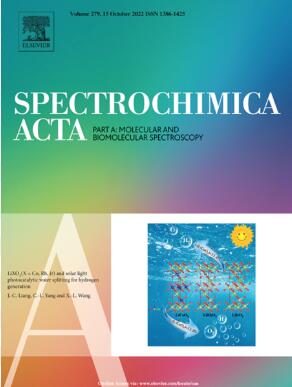SERS-fluorescence nanoprobe for monitoring and imaging mitochondrial ROS during cell apoptosis
IF 4.3
2区 化学
Q1 SPECTROSCOPY
Spectrochimica Acta Part A: Molecular and Biomolecular Spectroscopy
Pub Date : 2025-01-30
DOI:10.1016/j.saa.2025.125824
引用次数: 0
Abstract
Fumonisin B1 (FB1) is a mycotoxin that can induce oxidative stress in cells, leading to apoptosis. This study developed an innovative dual-mode nanoprobe that combines fluorescence and SERS detection to dynamically track the expression levels of mitochondrial reactive oxygen species (ROS) during FB1-induced apoptosis in cells. This probe utilizes gold-silver structured Au@AgNPs as the nanoprobes substrate, with mitochondrial-targeting polypeptide MLS labeled with the fluorescent molecule Rhodamine B modified on its surface, enabling precise targeting of cellular mitochondria. Upon the presence of ROS, the silver layer on the gold core is etched, causing the polypeptide chain attached to the silver surface to detach, which leads to the separation of Rhodamine B from the nanoprobe. This results in a decrease in Raman signals and an increase in fluorescence signals. SERS-fluorescence imaging results show that with prolonged FB1 exposure, the intracellular fluorescence signals increase while SERS signals decrease. The design of this nanoprobe fully utilizes the advantages of SERS and fluorescence dual detection, providing a novel tool for in-depth investigation of the toxin-induced apoptosis process.

sers荧光纳米探针用于细胞凋亡过程中线粒体ROS的监测和成像。
伏马菌素B1 (FB1)是一种真菌毒素,可诱导细胞氧化应激,导致细胞凋亡。本研究开发了一种创新的双模式纳米探针,结合荧光和SERS检测,动态跟踪fb1诱导细胞凋亡过程中线粒体活性氧(ROS)的表达水平。该探针利用金银结构Au@AgNPs作为纳米探针底物,在其表面修饰荧光分子罗丹明B标记线粒体靶向多肽MLS,能够精确靶向细胞线粒体。当ROS存在时,金核上的银层被蚀刻,导致附着在银表面的多肽链分离,从而导致罗丹明B与纳米探针分离。这导致拉曼信号的减少和荧光信号的增加。SERS-荧光成像结果显示,随着FB1暴露时间的延长,细胞内荧光信号增强,SERS信号减弱。该纳米探针的设计充分利用了SERS和荧光双重检测的优势,为深入研究毒素诱导的细胞凋亡过程提供了一种新的工具。
本文章由计算机程序翻译,如有差异,请以英文原文为准。
求助全文
约1分钟内获得全文
求助全文
来源期刊
CiteScore
8.40
自引率
11.40%
发文量
1364
审稿时长
40 days
期刊介绍:
Spectrochimica Acta, Part A: Molecular and Biomolecular Spectroscopy (SAA) is an interdisciplinary journal which spans from basic to applied aspects of optical spectroscopy in chemistry, medicine, biology, and materials science.
The journal publishes original scientific papers that feature high-quality spectroscopic data and analysis. From the broad range of optical spectroscopies, the emphasis is on electronic, vibrational or rotational spectra of molecules, rather than on spectroscopy based on magnetic moments.
Criteria for publication in SAA are novelty, uniqueness, and outstanding quality. Routine applications of spectroscopic techniques and computational methods are not appropriate.
Topics of particular interest of Spectrochimica Acta Part A include, but are not limited to:
Spectroscopy and dynamics of bioanalytical, biomedical, environmental, and atmospheric sciences,
Novel experimental techniques or instrumentation for molecular spectroscopy,
Novel theoretical and computational methods,
Novel applications in photochemistry and photobiology,
Novel interpretational approaches as well as advances in data analysis based on electronic or vibrational spectroscopy.

 求助内容:
求助内容: 应助结果提醒方式:
应助结果提醒方式:


